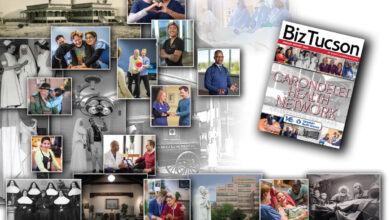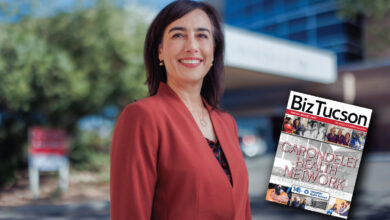
Swift, Coordinated Response to COVID-19
Medical Community Quickly Came Together
By Jay Gonzales
The images were haunting, yet in a small way, comforting.
America and the world were under siege like never before in our lifetimes from a deadly virus that came to be known as coronavirus and COVID-19.
But among the political divisiveness, the hoarding of supplies and the frustration of the isolation, there were images of heroes every day on the front lines of the massive efforts to save lives and protect our population.
They were everywhere. In the grocery stores. In the restaurants. Delivering the mail. Among the first responders. And they were at the hospitals and medical clinics which, from the images on television and social media, were seemingly outmanned from the outset by the pandemic.
However, according to local health officials and medical providers, the response in Tucson was swift and coordinated with unprecedented collaboration among everyone with a stake – which was essentially everyone in the community.
“I think the majority of Tucson felt like they owned part of our response. I can’t emphasize enough how important that was,” said Dr. Chad Whelan, CEO of Banner-University Medicine Tucson. “We mobilized as a community pretty quickly.”
“I think we were as ready as you can possibly be for a pandemic that the world has never seen,” said Jennifer Schomburg, CEO of Northwest Medical Center.
‘A new way of life’
As the crisis of the spring spilled into summer, the consensus is that communities throughout the nation will continue to experience the effects of the pandemic for longer than anyone can pinpoint – and in some aspects of society, for years to come. In the aftermath of the initial wave of the pandemic, the local healthcare community identified and attacked the initial challenges by taking a few days to a few weeks to make decisions and implement processes that normally would take months or even years of study and trial before execution.
“This pandemic took us to the deep end of the pool quickly,” said Nancy Johnson, a registered nurse and CEO of El Rio Health, which has more than 110,000 patients in its healthcare system spread throughout the region.
Across the board, hospitals and clinics recognized their first priority was coordination and safety. As the situation escalated into a worldwide health crisis in February and March, emergency response plans were put in motion. Some plans involved physical command centers being set up in meeting rooms and auditoriums or wherever a central gathering of expertise and communication could be established to deal with the onslaught of often-changing information and a potential surge of infected patients.
“Establishing our command center allowed us to quickly make sure we were highly organized and that we centralized the decision-making around COVID readiness,” Whelan said, pointing out that, in general, emergency response plans are built for short-term crises. “That’s not the optimal way to manage long-term, but during a time of rapid and massive changes, we needed to make sure that we were highly coordinated.
“We quickly framed our COVID response into four guiding principles that kept all of us focused, which were: one, protect our colleagues and patients; two, make sure that we could secure our supplies; three was surge planning and flexibility; and fourth was communicate broadly. We followed these throughout and they served us pretty well.”
Judy Rich, a registered nurse and president and CEO at Tucson Medical Center, said the long-term response to COVID-19 has been and will continue to be unlike anything longtime healthcare professionals have seen or will see in their careers. Having worked in hospital systems in Florida, she experienced the impact of dreadful natural disasters like hurricanes. Unlike those, she said, we are in this for the long haul.
“When you get ready for a hurricane, you can track it. You can see when it starts, to when it ends,” Rich said. “We don’t know when this is going to end, and we ended up keeping our command center up and running and staffed live for four weeks.
“We decided after four weeks that this was a new way of life and that we no longer needed to put everything through the incident command center. We had enough process in place and enough policy written down that we could guide our actions going forward without the incident command center.”
Safety and communication
When the gravity of the crisis became apparent and command centers were launched, the initial step was to ensure the safety of anyone who might have to be at a medical facility.
“Our first priority was really to keep our staff safe and our patients safe,” Rich said. “Everything we did in the early days was very much around personal protective equipment and working out processes that would keep everybody safe.”
There were various aspects to that, both procedural and physical.
The hospitals had to limit entry to their buildings. At Tucson Medical Center, a campus spread out with multiple entrances, entry was limited to five doors with staff at each door monitoring every person trying to enter the building. Other facilities made only one entrance available. Everyone who went into the facilities had to be screened for symptoms of the virus, including having their temperature taken.
Only those with a verified need to enter the building were allowed inside. Elective surgeries were put on hold. Visitors of patients, including those in grave condition from the virus, were prohibited.
Communication within the organizations and among all the providers and government agencies was crucial. Everyone involved was sharing information on everything from the spread of the virus to where to get personal protective equipment.
“The whole city was facing the same issue, so we had to really secure communication not only with our entities, but the other healthcare providers so that we could really share information on how to approach this,” said Frank Molinaro, CEO of Carondelet Health Network, which includes St. Mary’s and St. Joseph’s hospitals in Tucson and Holy Cross Hospital in Nogales.
Information was coming from different directions and changing by the hour. Government agencies at all levels were providing it. The Pima County Health Department became a conduit of information, locally. One of the challenges, though, was figuring out what was accurate and reliable.
“We had a lack of what I call the single source of truth,” Rich said, adding that Pima County became that reliable, central source of information for everyone in the region. “It was fulfilling to see all of us come together through phone calls with Pima County and through just reaching out to each other.”
The larger providers used resources within their systems, some of which are spread throughout the nation.
“Certain states were impacted before others so we were able to talk to our executives in different states and see what they were seeing, how are they responding, how is this affecting their operations, and how are they making adjustments,” said Kevin Stockton, regional president and market CEO for Northwest Healthcare.
Resources sometimes included trusted personal sources.
Schomburg, the CEO at Northwest Medical Center, said the hospital has a doctor on staff who had a personal contact at the University of Washington Medical Center in Seattle, which was essentially ground zero for the U.S. effects from the pandemic. The first confirmed COVID-19 case was in the state of Washington.
“One of our physicians was able to get his hands on the University of Washington policies and protocols,” Schomburg said. “We began significant education with our staff as well as our providers before Arizona even had cases, based off many of the protocols and policies and the experience that Washington was going through at that time.”
Local providers generally agree that adequate supplies of personal protective equipment – or PPE – was a constant concern, but did not reach the crisis level seen in other hard-hit areas of the country. Various contingencies were put in place just to make sure, but there was still an emotional toll from all of it.
“Our nurses weren’t having to work in garbage bags for PPE, but I will say this – the emotional impact was still there,” Molinaro said. “If you’re a nurse and you’re caring for potential COVID patients and there’s so much misinformation and new information and evolving information, those first days were very scary for all of us.
“While the scale (of the pandemic) wasn’t as big and the PPE crisis wasn’t as severe, the emotional impact was there. And we had to be creative. We actually ordered thousands of rain ponchos very, very early on as a backup for the gowns.”
A new normal
Faced with a crisis that is showing no definitive end and uncertainty about what the pandemic will look like in a month, six months, a year or even two, the healthcare community is bracing for a “new normal,” a term Whelan uses. Accessing healthcare in the future will turn toward technology and the use of non-traditional methods to ensure that routine care doesn’t become a health crisis because of COVID-19.
“The only thing I’m really sure of is, it’s going to be different,” Whelan said. “I think all of the things we’ve talked about in terms of enhanced precautions and more distance and more space, proactive testing protocols – those are all going to be part of our new normal.”





